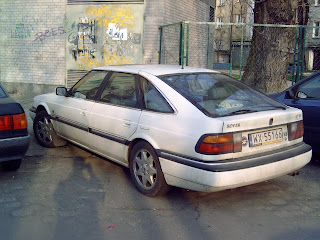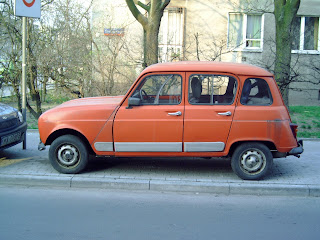 Britain has a history of marrying two things that you wouldn't normally expect together. Eggs in vinegar, for example, or Charles and Diana. Other times there are the incredible partnerships, when two very dissonant elements come together to create something far greater than the constituent parts, like putting milk into your tea.
Britain has a history of marrying two things that you wouldn't normally expect together. Eggs in vinegar, for example, or Charles and Diana. Other times there are the incredible partnerships, when two very dissonant elements come together to create something far greater than the constituent parts, like putting milk into your tea.In fact, some of the greatest relationships have been forged from the most curious of bedfellows. One scrawny feeble Englishman and one fat, oafish American, two people seemingly worlds apart, were able to form into the Hollywood success story of Laurel and Hardy, or Flim and Flam as they're known in Poland.
And what we're looking at here is the culmination of such an odd couple, the result of a time when the English and the Japanese were hopping in and out of each other's beds for most of the 1980s.
This wasn't some bastard offspring either. The car proudly sports Daddy's name on its front grille, bearing aloft the sigil of Rover, and while Mummy's name may only show up on a few official documents in certain registry offices, the maternal side hasn't been entirely diluted; especially when it's a family as famous as Honda.
To the uninitiated, two car companies coming together should be no big deal; it's happened dozens of times before in plenty of other countries. However, those previous pairings were full-on commitments, where one company takes the other hand in economic matrimony, buying the fairer half outright like some backwater village family in the 18th century. Peugeot walked down that aisle with Citroen in the Seventies, as did Rolls-Royce with Bentley forty years before them. But with Rover and Honda it was a much more modern affair. Certainly more than a casual fling, but nothing as severe as til-death-do-us-part. What we have here is a common law marriage, with the marital bed sitting somewhere in Morris Motor's factory in Cowley.
It's hard to say who wooed whom in the Rover-Honda dalliance. Rather than teenage passion, this was a more mature liason, with both sides being frank about what assets, and weaknesses, they were bringing to the table.
At the time, Rover certainly could hardly be considered an eligible bachelor, tied up as it was in the complicated knot of British Leyland, itself a heaving mass of automotive firms almost wholly financed by the British government. Rover wasn't pulling its weight within the group, and its flagship product, the Rover SD1, was a poor seller in contrast to its previous luxury saloons. It needed something new, something sleek, something executive to compete with the rapid growth of executive saloons that were flooding the market.
In contrast, Honda were becoming more and more aware that if they didn't expand their product range into the same sector, they'd be doomed forever to be an upstart motorbike manufacturer. While their small sedans, the Civic and Accord, were reasonable sellers domestically, they needed a much larger platform if they ever wanted to enter the lucrative American market.
Which is how, on a probably windy and rainy day in September 1981, Rover made the first call to Honda to suggest, you know, maybe getting together sometime to discuss what the future may bring. And a little over nine months later, the first clay model of Project XX was revealed, the embryonic form of what would later be the Rover 800.
The car enjoyed a relatively happy childhood. Both parents had ideas about what they wanted the car to be, and their visions were mutually beneficial. They wanted something solid, something powerful, something that would rise the corporate ladder and make its mark on the world. The clay models went through increasing revisions to make the car more defined and more present on the road, with a sleek look suited to the Eighties boardroom. To that end, Rover went about stuffing as much walnut dash and leather into the cabin as it could, while Honda set about shoehorning their new 2.5-litre V6 under the bonnet.
All considered, it should have been a knockout. Build quality was good, the trim level was competitive and performance was more than adequate. And with the two parents working in harmony, there was no hint of dysfunction at home either; Rover didn't suffer anywhere near as many strikes and walkouts as other British manufacturers of the time.
 What's more, the 800 had a trick up its sleeve that its big saloon contemporaries hadn't even thought about. Ford were conquering the bottom level of the market with their cheap and sturdy Granada, and luxury manufacturers like BMW offered both the E23 and E24 to cover the top end of the saloon and coupe markets. But neither had ventured into the executive hatchback market; a field that even Rover itself didn't consider that profitable.
What's more, the 800 had a trick up its sleeve that its big saloon contemporaries hadn't even thought about. Ford were conquering the bottom level of the market with their cheap and sturdy Granada, and luxury manufacturers like BMW offered both the E23 and E24 to cover the top end of the saloon and coupe markets. But neither had ventured into the executive hatchback market; a field that even Rover itself didn't consider that profitable.Neither, really, did Honda, who with great diplomacy admitted that they were far more interested in trying to produce a big coupe for the Americans. Rover had always known that the Japanese would favour a baby with their own name, but always believed that the Honda Legend, the 800's twin, would share the same factory. But it was not to be, and Honda moved their production to Japan to better focus on producing a luxury two-door that would sate the Yank appetite for big cars.
But there were no hard feelings, and when the time came Honda were more than happy to hand over their improved V6 to Rover to take the range to a whole new executive level, boosting capacity from 2.5 to 2.7 litres. Following suit, Rover gave the whole 800 range a more aggressive-looking grille to match the beefier performance, culminating in what we have here; a Rover 827si hatchback.
It could almost be a match made in heaven. Rover's insistence on producing an English sitting room inside a car, coupled with Honda's desire for supreme performance, meant that final product was both sporting and sumptuous; the perfect mix for people who had 20,000 pounds to throw at a car in 1992. Yet despite reasonable sales, it never really got to the heights destined for it, settling for the best of the bargain brands rather than a serious competitor to the top-shelf alternatives. By the time the car was cancelled in 1998, Rover had gone through four ownership changes, none of whom were prepared to invest in a follow-up to the 800's success.
In that way, this 827 stands as one of the last of its line, one of the Last Good Rovers. And while the line may have died out, its owner can still be proud, just like its parents were.


 Cast your mind back to childhood summer holidays, and some of us are old enough to remember bucket-and-spade days on the coast of our own country, slurping up ice creams and trying not to get pecked by seagulls. The seaside town I grew up in was one of those places; long sandy beaches, deckchairs in the sun, and the hourly mad dash to the pubs and cafes because it started raining again.
Cast your mind back to childhood summer holidays, and some of us are old enough to remember bucket-and-spade days on the coast of our own country, slurping up ice creams and trying not to get pecked by seagulls. The seaside town I grew up in was one of those places; long sandy beaches, deckchairs in the sun, and the hourly mad dash to the pubs and cafes because it started raining again.
 "Another glass, Jean-Jacques?"
"Another glass, Jean-Jacques?"
 The image of Volvo has always been one of a genteel conservatism. There's no outright snobbery involved in the brand, but those loyal to the Swedish manufacturer do seem to conform to a stereotype that may or may not be flattering. There's no posturing involved like other premium-priced models, no aggressive marketing designed to target a particular consumer. The Scandinavian manufacturer simply let its innocuous boxes appeal to innocuous people, as long as they had money to pay for it.
The image of Volvo has always been one of a genteel conservatism. There's no outright snobbery involved in the brand, but those loyal to the Swedish manufacturer do seem to conform to a stereotype that may or may not be flattering. There's no posturing involved like other premium-priced models, no aggressive marketing designed to target a particular consumer. The Scandinavian manufacturer simply let its innocuous boxes appeal to innocuous people, as long as they had money to pay for it.
 There was a time when the borders of Poland stretched from the Baltic coast as far as the Dnieper river, following its sinuous curves all the way to the Crimean peninsula. In those Golden Times the country, or the Polish-Lithuanian Commonwealth as it was known, was one of the largest countries in Europe, and a mighty force to be reckoned with. It embraced a multi-cultural society of Poles, Lithuanians and Ruthenians, defended itself from oppressive invaders, and enjoyed economic prosperity thanks to its exploitation of serfs and peasants. It fostered arts and sciences, maintained a diplomatic neutrality and led to the first constitution in Europe. All in all, it was a generally wonderful place to be. But there was one problem on it's eastern border, one trouble that couldn't be quelled. Cossacks.
There was a time when the borders of Poland stretched from the Baltic coast as far as the Dnieper river, following its sinuous curves all the way to the Crimean peninsula. In those Golden Times the country, or the Polish-Lithuanian Commonwealth as it was known, was one of the largest countries in Europe, and a mighty force to be reckoned with. It embraced a multi-cultural society of Poles, Lithuanians and Ruthenians, defended itself from oppressive invaders, and enjoyed economic prosperity thanks to its exploitation of serfs and peasants. It fostered arts and sciences, maintained a diplomatic neutrality and led to the first constitution in Europe. All in all, it was a generally wonderful place to be. But there was one problem on it's eastern border, one trouble that couldn't be quelled. Cossacks.


